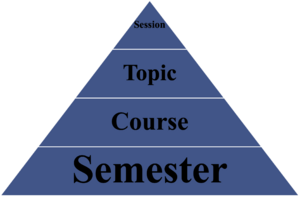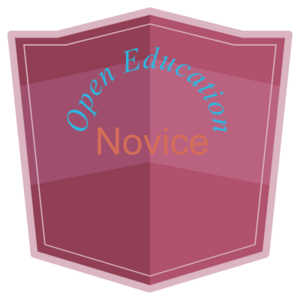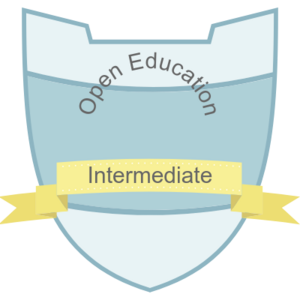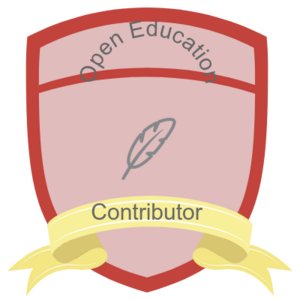CAS Digital Learning in Emergencies (2022-23)/module4-SalemAlhammadi
Module 4 Salem's page
Introduction
This page is the project for model 4 of Digital learning in emergency CAS for Salem.
Digital learning in emergencies is an educational program designed by Geneva university. The program is targeting the humanitarian staff who are working in the context of an emergency, and academic staff who are preparing to work in an emergency environment.
The program contains four different modules, each one of them focuses on different issues related to digital learning in emergencies. The courses are:
- Distance education in Higher education in emergencies contexts: experiences and lessons learned (Intro)
- Course Design and Development in Distance Education
- Foundations in Digital Literacy (special topics)
- Open Education in emergencies contexts: comparative and international perspective.
The project below is coming as a part of the last modules that is focusing on open education. In the first section of this wiki page you will find an overview of the project in general.
The project basically is a higher education program located in Kabul city, the capital of Afghanistan.
Summary of the project
The project aims to promote OE by practicing OE in both ways, helping the students understand how to use OER to their benefit, and asking them to contribute to OER by publishing their work.
The students will be asked to read some resources that discuss OER and to ensure they understood the basic ideas in the article, the students have to finish 2 quizzes. At the end, students have to design a project and publish it online as an OER.
Overview of the project
The project is a higher education project, located in the capital city of Afghanistan, Kabul. The global goal of the project is to train and educate Afghani to create a new generation of leaders who are able to lead and manage the state institutions effectively. The main audience of the project is young afghani youth between 21 to 25.
Context of the project
According to the fragile state index, Afghanistan is considered one of the most fragile states, which means that the state institutions cannot fulfill their duties and obligations and lack the human resources to run those institutions. Moreover, the country is lacking financial resources and suffers from decades of wars. Yet, the government is controlled by a group considered to have very narrow perspectives of tolerance and the acceptance of different points of view. Additionally, the country is threatened to fall into a new civil war. Moreover, the country is suffering from economic sanctions and is one of the most affected by climate change, in addition to being a landlocked country, which means it has no maritime borders and must depend on its neighbors for importing and exporting.
Objectives& Outcomes
Global
1- To train and educate Afghani to create a new generation of leaders who are able to lead and manage the state institutions effectively.
Local
1- The ability to understand, and develop flexible foreign policy, and manage the relationship with the regional power
2- The ability to build a modern economy that is utilizing its local comparative advantage
Outcomes
1- Understand the situation in the country from different aspects
2- Identify the main challenges either local, regional, or global
3- Design and manage realistic national projects
4- Identify the strengths to use them, and the limitations to avoid them
Project Structure
The project will last for 3 years and cover 6 semesters, each semester will last for 5 months. In each semester there will be 5 courses. Each course covers different topics, some topics will have only one session, and another topic might have up to 8 sessions.
Open Education Activites
The following sections illustrate how the program will be an open education program at the level of the session. Open education will cover two sides. It will use open education resources as a part of student's education and learning. The other side is that students' work, reports, research, and reflections will be published online, under the open educational recourses policy. I would like to emphasize that open education will not be taught as a concept, but open education as a methodology will be used to teach students certain topics, and at the same time to make the students experience open education by participating in promoting the concept through publishing their work online under open educational resources policy as mentioned above.
Learning outcomes
1- To search and find relevant online open educational resources.
2- Sharing the work using online means as an open educational resource.
Expected time: 25 Hours
Detailed Description
1- Read the attached resource from UNESCO that defines open education resources.
2- Read the second attachment that discusses the challenges of open education in higher education.
3- Explore the third attachment to find different open educational resources.
4- Find an academic resource that discusses one of the following topics that we already discussed during our sessions:
- History of political thoughts
- Peace and conflicts
- Political actors
- International affairs theories: Realism
- International affairs theories: Liberalism
5- Discover and analyze one resource that interests you.
6- Produce a written, video, or audio reflection for the chosen material, and publish it online as an open educational resource.
Expected results
- Write a short reflection- 500 words- explaining what the UNESCO article discussed.
- List and explain the benefits and challenges of open education in higher education briefly according to the article.
- Explain with no more than 500 words what OER you have chosen, and the reason for chosing them.
- After choosing the topic for project, complete the below activities.
Resources
1- UNESCO Open Education Resources
2- Open education resources’ benefits and challenges in the academic world: a systematic review
3- Open Educational Resources: Where to Find
4- Commons: website for finding and sharing open resources and materials
Tools for publications
The following methods are some online, free, and widely used platforms that could be used to publish your work, and contribute to open education. However, any other tools are welcomed as long as its online, accessible, and free.
1- YouTube video
2- Wikipedia
3- Podcast apps
4- Personal blogs
5- Social apps such as Twitter, Facebook, etc…
6- Commons network
Activities
| Activity | Time to Finish | Evaluation | Reward |
|---|---|---|---|
| Reading first resources | 4 Hours | Quiz | Open education badge/ Novice |
| Reading second resources | 6 Hours | Quiz | Open education badge/ Intermediate |
| Produce a reflection on one selected ed material | 15 Hours | Mini project | Open education badge/ Contributor |
Rewards
1- Open education badge Novice:
The student who is awarded this badge has shown the ability to understand what open education is, how it developed, and why it is important in the contemporary context.
2- Open education badge Intermediate:
The student has demonstrated well basic knowledge regarding the challenges and opportunities that are combined with open education in the higher education domain.
3- Open education badge Contributor:
The student has shown his ability to find and use open education resources. In addition to contributing to open education by sharing his work under the open education policy.
Evaluation Criteria
For the last activity, students will be asked to do a mini project based on the topics they selected, and the OERs they chose to analyze. The project could be either a written, video, or audio file, and the student can choose one of the above mentioned online tools to publish his work as an OER. The Evaluation will be an open evaluation. Every student will be asked to observe his colleague's work, and evaluated it based on the criteria. students will be evaluated based on a summative criteria-based evaluation Using 5*5 Rubric.
| Criteria | 4 | 3 | 2 | 1 | 0 |
|---|---|---|---|---|---|
| The context of the project, geography, main parties, and history of the situation. | The student has an excellent understanding of the context and clearly defines all relevant aspects of the geography, main parties, and history of the situation. The student's explanation of the context is well-organized, clear, and detailed, and demonstrates a thorough understanding of the situation. | The student has a very good understanding of the context and defines most of the relevant aspects of the geography, main parties, and history of the situation. The student's explanation of the context is clear and mostly detailed, but may have some minor misunderstandings or omissions. | The student has a weak understanding of the context and omits some important aspects of the geography, main parties, and history of the situation. The student's explanation of the context is incomplete or unclear, and demonstrates a limited understanding of the situation. | The student has a very poor understanding of the context and omits many important aspects of the geography, main parties, and history of the situation. The student's explanation of the context is incomplete and demonstrates a lack of knowledge about the context. | N/A |
| Analyzing the context based on one or more of the learned theories.
|
The student demonstrates an excellent understanding of the theories and establishes a clear and well-supported link between the context and the theories. The student's analysis is well-reasoned and includes evidence to support their argument. | The student demonstrates a very good understanding of the theories and establishes a clear link between most of the context components and the theories. The student's analysis includes some evidence to support their argument, but may be incomplete or not fully supported. | The student demonstrates a weak understanding of the theories and does not establish a clear link between the theory and the context. The student's analysis lacks evidence to support their argument and is not well-reasoned. | The student demonstrates a very weak understanding of the theories and does not establish any link between the theories and the context. The student's analysis lacks any evidence or support. | N/A |
| Identify and explain phenomena and components related to the context and the theories can not explain or predict, and come up with alternative theoretical framework to explain | TThe student well identifies and explains related phenomena beyond the ability of theories to explain, and suggests a strong and well-supported alternative theoretical framework to explain them. The student's explanation demonstrates a deep understanding of the phenomena and the alternative theoretical framework. | The student identifies and explains some related phenomena beyond the ability of theories to explain, but does not suggest a strong or well-supported alternative theoretical framework. The student's explanation may be incomplete or lack depth of understanding. | The student identifies a related phenomenon beyond the ability of theories to explain, but does not suggest an alternative theoretical framework. The student's explanation of the phenomenon may be incomplete or lack depth of understanding. | The student does not identify any related phenomena beyond the ability of theories to explain, and does not suggest an alternative theoretical framework. | N/A |
| Clear Academic language, with clear and understood ideas. | The student's ideas are very clear and the language used is strictly academic and meets high standards of clarity and formality. | The student's ideas are clear, but the language used is not consistently academic and may include some non-formal elements. | The student's ideas are clear, but with some limitations, and the language used is mixed between academic and non-formal. | The student's ideas are not clear, and the majority of the paper is written in non-formal language. | N/A |
|
Using OER, and contributing to them by using any online, accessible, and free tool |
The student has used OER appropriately and has made a significant contribution to the OER ecosystem by using online, accessible, and free tools. The student's contribution is easily accessible and does not require any registration or special access. | The student has used OER, but their contribution is not easily accessible or requires some sort of registration or special access. | The student has used OER, but their contribution is not accessible and requires significant registration or special access. | The student has not used any OER, and their contribution is not considered an OER. | N/A |
Refrences
CAS Digital Learning in Emergencies



